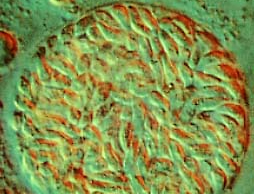In modern society, pet cats and dogs have entered more and more human families and become part of many families. Some families even keep five or six pet cats at the same time.
As the name suggests, toxoplasmosis is a zoonotic parasitic disease caused by Toxoplasma gondii infection.
1. The main hazards of Toxoplasma gondii
Toxoplasma gondii is extremely harmful to pregnant women and fetuses. After pregnant women are infected with Toxoplasma gondii, they can be transmitted to the fetus through the placenta, resulting in miscarriage, stillbirth, deformity or congenital toxoplasmosis in infants.
2. Life history of Toxoplasma gondii
Toxoplasma gondii has five developmental stages, including trophozoites, cysts, schizonts, gametophytes and oocysts.
Figure 1 Toxoplasma feline oocyst

Figure 2 Toxoplasma gondii cysts
1. Intermediate host
Dogs are the intermediate host of Toxoplasma gondii, which can be congenitally and acquiredly infected with Toxoplasma gondii.
Figure 3 Toxoplasma gondii cysts in cats
2. The final host
Cats are the ultimate host of Toxoplasma gondii. Toxoplasma gondii can complete all developmental stages in its body and excrete oocysts in feces.
Figure 4 Laboratory diagnosis of toxoplasmosis
II. Prevention of Toxoplasmosis
At present, there is no ideal drug for the treatment of pet toxoplasmosis.
1. Pay attention to the hygiene of feeding and management. The cat should be allowed to live in a fixed place, not stocked, and allowed to roam outside;
2. Eat finished food for dogs and cats, and do not let them prey freely outside, so as not to eat mice or birds that have been infected with Toxoplasma gondii and bring Toxoplasma gondii home;
3. Remove dog and cat feces every day, because the oocysts in cat feces need to develop in the outside world for two to five days to become infectious, so it is very important to deal with cat feces in time; pet rice bowls should be separated from other utensils.
4. Avoid being scratched and bitten by pets, and try not to have too close contact with pets, such as sharing meals at the same table and sleeping in the same bed; try not to let pets lick people's hands and faces; bathe pets often.
Figure 5 Toxoplasma gondii infection in cats
III. Summary and discussion
As far as the current medical level is concerned, there is a certain degree of uncertainty in the diagnosis and treatment of pet toxoplasmosis, so prevention is particularly important to avoid pet toxoplasmosis.
